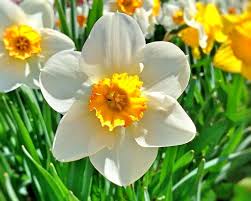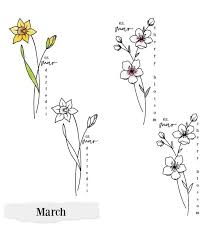March, the transitional month between winter and spring, heralds the arrival of vibrant blooms and the promise of new beginnings. For those fortunate enough to be born in this lively month, their birth flowers are daffodils and jonquils, symbolic representations of hope, rebirth, and rejuvenation.
These delicate blossoms, with their cheerful colors and enchanting fragrance, embody the essence of spring and capture the spirit of March birthdays.
Daffodils, scientifically known as Narcissus, are a captivating sight with their sunny yellow petals and trumpet-like corona. These flowers possess a rich history and have been celebrated in various cultures for centuries. In Greek mythology, the narcissus flower was believed to have emerged from the tears of the god Narcissus, who fell in love with his own reflection.
Consequently, daffodils are often associated with self-love, beauty, and vanity. However, their symbolism has evolved over time, and today, these blooms represent more positive qualities, such as renewal, prosperity, and the joy of life.
The daffodil’s arrival in early spring symbolizes the triumph of light over darkness, as it emerges from the cold ground, piercing through the remnants of winter. It serves as a powerful reminder that no matter how long the winter may be, spring will inevitably arrive, bringing with it a sense of hope and optimism.
The vibrant yellow hue of the daffodil is reminiscent of sunshine, symbolizing the warmth and energy that spring brings after the cold and gloomy days.
Jonquils, a subspecies of daffodils, are another exquisite variety associated with March birthdays. They bear a resemblance to daffodils but are smaller in size and possess multiple blossoms per stem. Jonquils are often characterized by their sweet and alluring fragrance, which adds an extra element of charm to their already captivating appearance. Like daffodils, jonquils symbolize rebirth and renewal, but they also represent affection and deep, heartfelt emotions.
These delicate blooms have the ability to convey a sense of sincere love and adoration, making them perfect for expressing sentiments to those born in March.
The daffodil and jonquil’s inherent beauty and significance have made them popular choices for various celebrations, including birthdays, weddings, and even the welcoming of spring festivals. Their cheerful and vibrant nature has the power to lift spirits and inspire a sense of joy and optimism. Additionally, these flowers hold great sentimental value and make for thoughtful gifts, whether as a bouquet or a potted plant, to commemorate March birthdays and special occasions.
When March arrives, and nature awakens from its slumber, daffodils and jonquils unfurl their delicate petals, bringing an abundance of color and fragrance to the world. They serve as a gentle reminder that even amidst life’s challenges, there is always hope and the possibility of new beginnings.
So, as we celebrate the arrival of spring and the birthdays of those born in March, let us embrace the beauty and symbolism of these charming flowers and be inspired by their message of resilience, renewal, and the everlasting cycle of life.
History and Significance of March Birth Flowers

The history and significance of March birth flowers, daffodils and jonquils, can be traced back centuries, encompassing various cultural and mythological references. These flowers have captured the imagination of people throughout history and continue to hold deep symbolic meanings associated with the month of March.
The daffodil, also known by its scientific name Narcissus, has a rich and fascinating history. Its name is derived from the Greek mythological character Narcissus, who was known for his extraordinary beauty.
According to the myth, Narcissus fell in love with his own reflection in a pool of water and eventually transformed into the flower that now bears his name. In this context, daffodils symbolize self-love, vanity, and the fleeting nature of beauty.
Over time, the symbolism of daffodils has evolved to represent more positive qualities. In various cultures, they have become synonymous with the arrival of spring, rejuvenation, and the triumph of life over the darkness of winter.
Daffodils are often associated with hope, optimism, and the promise of new beginnings. Their vibrant yellow color, reminiscent of sunshine, signifies warmth, joy, and happiness. Daffodils have become an iconic symbol of the changing seasons and are widely recognized as a harbinger of spring.
Jonquils, a specific type of daffodil, also hold historical and cultural significance. They are named after the Spanish word “jonquil,” which refers to a fragrant yellow flower. The delicate and alluring fragrance of jonquils sets them apart from other daffodil varieties.
In the language of flowers, jonquils symbolize deep affection, desire, and the expression of heartfelt emotions. They are often associated with romantic love and have been used to convey sentiments of love and admiration.
In addition to their symbolic meanings, daffodils and jonquils have been used in various traditional and cultural celebrations. In the United Kingdom, daffodils are prominently featured during the annual celebration of St. David’s Day on March 1st, which honors the patron saint of Wales. Daffodils are also associated with Easter, as their blooming coincides with the holiday and represents the resurrection and new life.
The beauty and significance of daffodils and jonquils have inspired artists, poets, and writers throughout history. From William Wordsworth’s famous poem “I Wandered Lonely as a Cloud” to the delicate brushstrokes of Vincent van Gogh’s paintings, these flowers have been immortalized in art as symbols of beauty, hope, and the wonders of nature.
As March birth flowers, daffodils and jonquils hold a special place in the hearts of individuals born in this month. They serve as reminders of the unique qualities associated with March birthdays: resilience, optimism, and the ability to embrace new beginnings.
Whether gifted in bouquets or enjoyed in gardens, daffodils and jonquils bring a touch of brightness and joy to the lives of those who celebrate their birthdays during this transitional month.
In addition, the history and significance of March birth flowers, daffodils, and jonquils, are rooted in mythology, cultural traditions, and the symbolism of spring. These flowers symbolize hope, renewal, and the triumph of life over adversity. They serve as timeless reminders of the beauty and resilience of the human spirit and continue to captivate and inspire people around the world.
Read Also: February Flowers Complete Growing Guide
Uses of the March Birth Flower
The March birth flowers, daffodils and jonquils, offer more than just their beauty and symbolism. These vibrant blooms have a range of practical and decorative uses, making them versatile and cherished by enthusiasts of floral arrangements.
Here are some of the common uses of daffodils and jonquils:
1. Floral Bouquets: Daffodils and jonquils are popular choices for creating stunning floral bouquets. Their vibrant yellow and white hues add a burst of color and radiance, making them ideal for spring-themed arrangements. Whether used alone or combined with other complementary flowers, these blooms create eye-catching displays that can brighten any room or occasion.
2. Indoor Decoration: Daffodils and jonquils are excellent for bringing the beauty of spring indoors. Placing a vase of these flowers on a table or mantle can instantly liven up the atmosphere and create a cheerful ambiance. Their lovely fragrance adds an extra element of charm, filling the room with a pleasant scent.
3. Outdoor Gardens: March is the time when daffodils and jonquils bloom, making them popular choices for outdoor gardens. These flowers can be planted in flower beds, borders, or containers to add bursts of color and interest to the landscape. They are relatively low-maintenance and can thrive in various climates, making them versatile options for gardeners.
4. Symbolic Gift Giving: Daffodils and jonquils hold deep symbolic meanings, making them thoughtful and meaningful gifts. They can be given to celebrate birthdays, anniversaries, or other special occasions, conveying messages of hope, renewal, and affection. A bouquet of these flowers can brighten someone’s day and serve as a reminder of the beauty and positivity associated with March.
5. Medicinal Purposes: In traditional herbal medicine, daffodils have been used for their potential health benefits. However, it’s important to note that daffodils contain toxic compounds and should not be ingested without proper guidance from a qualified healthcare professional. As such, their medicinal use should be approached with caution and expert advice.
6. Cultural and Festive Celebrations: Daffodils and jonquils are often incorporated into cultural and festive celebrations around the world. In addition to St. David’s Day in Wales, daffodils are associated with the Persian New Year celebration called Nowruz, where they symbolize the arrival of spring and the renewal of nature. They can be used as decorative elements during these celebrations, adorning homes and public spaces.
It’s worth mentioning that when using daffodils and jonquils for any purpose, it’s important to handle them with care. Some people may have allergies or sensitivities to these flowers, so it’s advisable to be cautious and take necessary precautions.
Whether admired for their aesthetic appeal, cherished for their symbolism, or utilized for various practical purposes, the March birth flowers, daffodils and jonquils, offer an array of uses that contribute to their enduring popularity. Their presence brings joy, beauty, and a sense of renewal, perfectly capturing the spirit of the changing seasons and the celebration of life.
Read Also: January Flowers Complete Growing Guide
March Birth Flowers Complete Growing Guide

If you’re interested in cultivating the March birth flowers, daffodils and jonquils, in your garden or as potted plants, this comprehensive growing guide will provide you with the necessary information to help you succeed.
Growing Daffodils and Jonquils
1. Planting: Daffodils and jonquils are typically grown from bulbs. Choose a location with full sun to partial shade. These flowers prefer well-draining soil. Plant the bulbs in late summer or early fall, before the ground freezes.
2. Soil Preparation: Prepare the soil by removing weeds and loosening it to a depth of about 8-10 inches. Incorporate organic matter, such as compost or well-rotted manure, to improve soil fertility and drainage.
3. Planting Method: Dig a hole that is about three times the height of the bulb. Place the bulb in the hole with the pointed end facing upward. Space the bulbs according to the recommended distance for the specific variety. Cover the bulbs with soil, gently firming it down.
4. Watering: Water the bulbs immediately after planting to settle the soil around them. After that, daffodils and jonquils generally do not require much additional watering, as they prefer drier conditions. However, during prolonged dry spells, provide supplemental watering to keep the soil slightly moist.
5. Mulching: Apply a layer of organic mulch, such as straw or wood chips, around the base of the plants. Mulching helps retain moisture, suppress weeds, and regulate soil temperature. Keep the mulch a few inches away from the emerging shoots to prevent rotting.
6. Fertilization: Daffodils and jonquils are not heavy feeders but benefit from a balanced slow-release fertilizer applied in early spring. Follow the manufacturer’s instructions for the appropriate dosage. Avoid excessive fertilization, as it can lead to excessive foliage growth and reduced flower production.
7. Maintenance: After flowering, allow the foliage to die back naturally. This process helps the bulbs store energy for next year’s blooms. Do not cut back or braid the foliage until it turns yellow and withers. Remove spent flowers to prevent the plants from setting seed.
8. Pest and Disease Control: Daffodils and jonquils are generally resistant to pests and diseases. However, occasionally they may encounter issues with bulb-feeding pests like narcissus bulb flies or fungal diseases like narcissus basal rot. Proper sanitation practices, such as removing and destroying infected plant parts, can help prevent the spread of diseases. Organic insecticides and fungicides can be used if necessary.
By following these guidelines, you can successfully grow daffodils and jonquils, the March birth flowers, in your garden. With their vibrant colors and cheerful blooms, these flowers will bring joy and beauty to your outdoor space in early spring.





